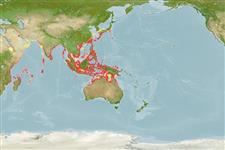>
Anguilliformes (Eels and morays) >
Ophichthidae (Snake eels) > Ophichthinae
Etymology: Brachysomophis: Greek, brachys, eia = short + Greek, soma = body + Greek, ophis = serpent (Ref. 45335); cirrocheilos: From apparently a combination of Latin ('cirrus' = tendril) and Greek ('cheilos' = lip)..
More on author: Bleeker.
Environment: milieu / climate zone / depth range / distribution range
Sinh thái học
Biển; Thuộc về nước lợ Cùng sống ở rạn san hô; Mức độ sâu 1 - 38 m (Ref. 42180). Tropical; 39°N - 20°S, 35°E - 148°E (Ref. 42180)
Indo-West Pacific: Red Sea and East Africa to Japan, Taiwan south to Indonesia and Australia.
Bộ gần gũi / Khối lượng (Trọng lượng) / Age
Maturity: Lm ? range ? - ? cm
Max length : 159 cm TL con đực/không giới tính; (Ref. 42180)
Short description
Hình thái học | Sinh trắc học
Động vật có xương sống: 135 - 140. Coloration pale, overlain dorsally and along flanks with irregular brown smudges. A moderately elongate species with tail 51-58% and head 11-14% of TL; dorsal fin arising well behind pectoral-fin tips; pectoral fins not elongate; snout moderate, about 3.2 in jaw; jaws elongate; lower jaw extending beyond snout; nostrils in very short tubes in upper lip and closely associated; labial fringe well-developed but cirri not elongate on jaws, with cauliflower-like projections at tips; center of eye behind anterior 40% of jaw; interorbital space and top of head flat, dorsal head profile nearly flat from mid-head to snout tip; head pores inconspicuous; free sensory neuromasts not visible on nape; teeth conical. Numerous prominent barbels on both lips; outer row of maxillary teeth not visible when are closed (Ref 42180).
Most commonly found in sand and mud, near coastal reefs at depths of 1 up to at least 10 m. Burrows into the sand tail-first until only its eyes and the top of its snout are visible. Sometimes seen with only its head or snout protruding from the sand. More commonly encountered at night but also seen with its head protruding out of the substrate during the day. Observed with cleaner shrimp Periclimenes magnificus on its head. The shrimp would swim off for short periods and then return to this species (Ref. 42180). Feeds on small fishes and crustaceans (Ref. 2334).
Life cycle and mating behavior
Chín muồi sinh dục | Sự tái sinh sản | Đẻ trứng | Các trứng | Sự sinh sản | Ấu trùng
McCosker, J.E. and J.E. Randall, 2001. Revision of the snake-eel genus Brachysomophis (Anguilliformes: Ophichthidae), with description of two new species and comments on the species of Mystriophis. Indo-Pac. Fish. (33):1-32. (Ref. 42180)
IUCN Red List Status (Ref. 130435)
Threat to humans
Harmless
Human uses
Thêm thông tin
Age/SizeSự sinh trưởngLength-weightLength-lengthLength-frequenciesSinh trắc họcHình thái họcẤu trùngSự biến động ấu trùngBổ xungSự phong phúBRUVS
Các tài liệu tham khảoNuôi trồng thủy sảnTổng quan nuôi trồng thủy sảnCác giốngDi truyềnElectrophoresesDi sảnCác bệnhChế biếnNutrientsMass conversion
Các công cụ
Special reports
Download XML
Các nguồn internet
Estimates based on models
Preferred temperature (Ref.
123201): 25 - 29, mean 27.9 °C (based on 520 cells).
Phylogenetic diversity index (Ref.
82804): PD
50 = 0.5078 [Uniqueness, from 0.5 = low to 2.0 = high].
Bayesian length-weight: a=0.00089 (0.00039 - 0.00204), b=3.00 (2.80 - 3.20), in cm total length, based on LWR estimates for this (Sub)family-body shape (Ref.
93245).
Mức dinh dưỡng (Ref.
69278): 4.0 ±0.66 se; based on food items.
Thích nghi nhanh (Ref.
120179): thấp, thời gian nhân đôi của chủng quần tối thiểu là 4.5 - 14 năm (Preliminary K or Fecundity.).
Fishing Vulnerability (Ref.
59153): Very high vulnerability (90 of 100).
